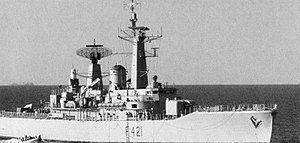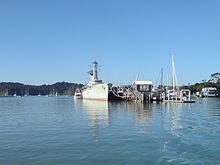 HMNZS Canterbury (F421) was one of two broad beam Leander-class frigates operated by the Royal New Zealand Navy (RNZN) from 1971 to 2005. She was built in Scotland and launched in 1970. Commissioned in 1971, Canterbury saw operational service in much of Australasia and other regions like the Persian Gulf. She undertook operations such as supporting UN sanctions against Iraq and peace-keeping in East Timor. With her sister ship HMNZS Waikato she relieved the Royal Navy frigate HMS Amazon in the Indian Ocean during the Falklands War.
HMNZS Canterbury (F421) was one of two broad beam Leander-class frigates operated by the Royal New Zealand Navy (RNZN) from 1971 to 2005. She was built in Scotland and launched in 1970. Commissioned in 1971, Canterbury saw operational service in much of Australasia and other regions like the Persian Gulf. She undertook operations such as supporting UN sanctions against Iraq and peace-keeping in East Timor. With her sister ship HMNZS Waikato she relieved the Royal Navy frigate HMS Amazon in the Indian Ocean during the Falklands War.
Early in HMNZS Canterbury's career she relieved the frigate HMNZS Otago at Moruroa during anti-nuclear protests, in 1973, F 421 being the most effectively insulated frigate, from nuclear fallout, with the Improved Broad Beam Leander steam plant, for e.g., being remote controlled and capable of unmanned operation and therefore the ship a more effective sealed citadel for operations in areas of nuclear explosions. Canterbury was decommissioned in 2005. In 2007 she was scuttled in the Bay of Islands to provide a dive wreck. She lies in 38 metres (125 ft) of water.

After being decommissioned in 2005, there was talk of converting her into a floating hostel. However, during a 2004 inspection, corrosion of the ship's structure had been found to be too serious for her to stay afloat in the long term without very costly maintenance. Enthusiasts at the Bay of Islands Canterbury Charitable Trust proposed the idea of scuttling her as a dive wreck at Deep Water Cove in the Bay of Islands.
 The New Zealand Navy ships Tui and Waikato are already lying on the ground off the Tutukaka Coast, while the Greenpeace ship Rainbow Warrior was scuttled off Matauri
Bay. It is hoped that the wreck, in addition to becoming an artificial reef
enhancing biodiversity, will also provide additional options for the regions
diving tourism.[25] It is considered that removed scrap metal and equipment
(such as ship's lockers or the propeller) will bring up to NZ$400,000 to offset
the NZ$650,000 costs of cleaning up and scuttling her, while the worth to the
local economy could be in the millions. The ship itself had been sold to the
trust for a symbolic NZ$1. Her 4.5-inch Mk V/Mk 6 gun turret was removed to
become part of the exhibits at a planned new navy museum in Auckland.
The New Zealand Navy ships Tui and Waikato are already lying on the ground off the Tutukaka Coast, while the Greenpeace ship Rainbow Warrior was scuttled off Matauri
Bay. It is hoped that the wreck, in addition to becoming an artificial reef
enhancing biodiversity, will also provide additional options for the regions
diving tourism.[25] It is considered that removed scrap metal and equipment
(such as ship's lockers or the propeller) will bring up to NZ$400,000 to offset
the NZ$650,000 costs of cleaning up and scuttling her, while the worth to the
local economy could be in the millions. The ship itself had been sold to the
trust for a symbolic NZ$1. Her 4.5-inch Mk V/Mk 6 gun turret was removed to
become part of the exhibits at a planned new navy museum in Auckland.
(Extract from Wikipedia)